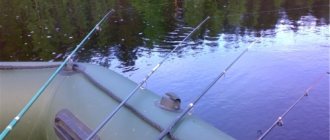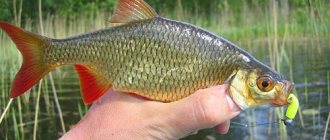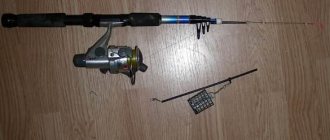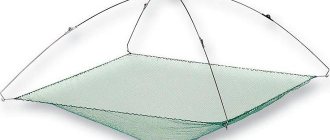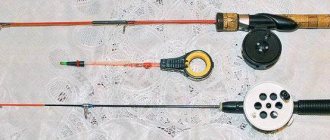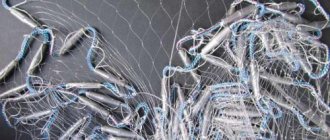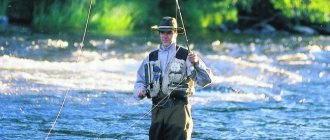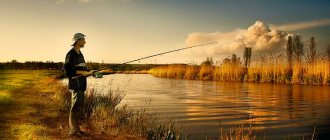Balachevtsev M. | May 12, 2000
There has been so much talk lately about this cutting-edge gear. For a long time I did not dare to write about this. separate article, since I could not decide for myself the question of the applicability of this Western innovation to the conditions of Russia.
In my articles, I try to be closer to the average “amateur” than to athletes, and the possibility of using a plug in amateur fishing seemed very doubtful to me. What's so inconvenient about the plug? Before we talk about the disadvantages and advantages of “plug” fishing, let’s take a closer look at this gear.
Rod
What is a plug rod? Its length can be from 8 to 16 meters, although there are shorter and longer models, but this is the exception rather than the rule. The maximum length of plug rods reaches 18 - 20 meters. On the other hand, you can always make a shorter rod out of a longer rod by just unfastening a certain number of legs. A plug rod consists of a main rod and one or more ends (whales). These end switches can have different lengths and are partly telescopic and partly plug-in. Usually the first two or less often three elbows are telescopic.
On average, one fishing rod is equipped with two to three additional ends of three to four meters in length. In order not to be unfounded, I will give several examples of plug rod configurations. A rod with a tip with a total length of 14.5 meters + 2 four-legged ends + 2 five-legged ends + 1 two-legged end. A rod with a tip with a total length of 13 meters + 2 four-knee ends + 1 five-knee end. A rod with a tip with a total length of 14 meters.
End caps can be purchased additionally as needed. Also, for some models you can purchase extension butt knees that increase the length by 1.5 meters. The material and manufacturing technology of plug rods are significantly different from the “flying” sticks we are familiar with. They are significantly stiffer, which is their main advantage. In principle, a plug rod should not bend under the weight of the fish. The less it bends, the better. The second indicator of the quality of a plug is its weight.
Here are some characteristics of plug rods in different price categories:
14.5 meters - 950 grams - one of the most expensive and high-quality fishing rods (more than 2000 USD) 14.5 meters - 1100 grams - an average quality rod, the most suitable both in price and quality (2000-600 USD .e.) 14.5 meters - 1300 grams - the least quality rod, hardly suitable even for beginners. (up to 600 USD) Now quite decent Russian-made fishing rods in the price category below 500 USD have begun to appear on the market (Moscow).
There are two other things to consider when choosing. There are so-called carp rods, which, while maintaining high quality, have a little more weight than regular rods. Simply, these rods are thicker and more durable. And one moment. According to statistics, it is expensive, high-quality fishing rods that break more often due to the fact that these fishing rods are lighter and, therefore, thinner-walled. It’s quite difficult to break a $500 stick, but a rod that costs several thousand can break from a slight blow to a hard object.
Device
It is the design of the limit switch that is of interest. The rod itself is just a set of lightweight carbon fiber tubes. The end piece consists of 2 - 3 telescopic and several plug-in elbows, and the last butt-end elbow is plugged onto the main (base) rod. Shock-absorbing rubber with a length of 40 centimeters and up to 2-3 meters is installed inside the end switch. This is a special plug rubber that, when stretched, increases its length by 5-6 times, which makes it possible to dampen fish jerks so well. The rubber is quite durable. Purchased separately, in skeins of 5 meters. Different fish (by weight) require rubber of different diameters (numbers).
The inner end of the rubber is secured in the first, second or third bend of the limit switch (counting from the thinnest) using a special plug.
Stubs
There can be three types. The simplest is a short cone (about 2-4 cm) made of plastic. The rubber is tied to a special eyelet. The cone simply jams in a certain place on the end switch (depending on the diameter of the cone, this place can be in the first elbow, or in the second, or in the third). The second option is the same cone, but with a variable diameter. The diameter is changed using a threaded spacer. With its help you can change both the length and the tension of the rubber. The third version of the plug is the same cone, but inside it there is a device for winding rubber (usually a reel). This type allows you to change the tension of the rubber.
The second end of the rubber ends with a small (1 - 2 cm) plastic fastener. The rubber is tied to a special eyelet of the fastener. The scaffolding is attached to the other side of the fastener.
The rubber tension depends on the expected production. For medium fish (200 - 300 grams) I do the following. Let's say the length of the rubber will be equal to the length of two knees (this is about 1.2 meters). I install the rubber in a loose (slightly tense) state and stretch it 10 - 20 centimeters. That is, the rubber should be stretched during installation by 10 - 15, less often 20%. This tension will ensure a normal hook.
To ensure that the rubber does not fray at the point of exit from the end cap, a fluoroplastic tube is installed at its tip. Now the rubber does not rub against the sharp edges of the carbon fiber tip, but passes through a smooth bushing. The diameter of the latter is slightly smaller than the diameter of the whip outlet.
Equipment
The equipment of a plug rod is practically no different from the equipment of a conventional “fly” rod. The length of the rigs strictly depends on the fishing depth and exceeds it by 0.5 - 1 meter. This type of gear differs from equipment for “fly” rods only by its greater miniature size, and also, in some cases, by the location of the load. Thinner scaffolding and floats of lower carrying capacity are used. Thinner lines are used due to the fact that the shock absorber located inside the rod softens the jerks of the fish much better. An example of this is the experience of Russian competitions in recent years, when almost kilogram ides were pulled out with a 0.06 mm leash. The use of lighter floats is due to the fact that the tackle is not cast as such; the tackle is simply “pushed out” to the fishing point. Thin lines and a small float are always an advantage.
Plug rod equipment
In general, plug-in equipment differs little from that used in float fishing. It consists of a float, a loading system and a hook. The determining factor is the length of the fishing line. It should be equal to the depth at the fishing point plus 0.5–1.2 meters.
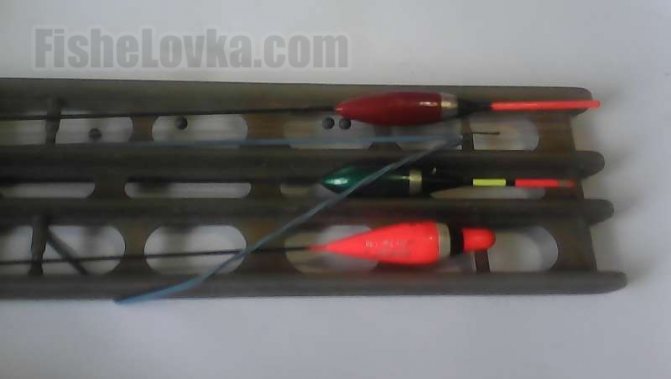
Photo 1. Spare equipment.
Naturally, fishing conditions, even within the same zone, can change significantly, so you will have to constantly redo the equipment, changing its length and load. Seasoned fishermen prepare several options ahead of time at home, reel them on a reel and take them with them to the pond.
Important! It should be taken into account that the equipment does not get tangled; it should be shorter than the length of the whale, up to half a meter.
When making equipment, a fisherman can use ultra-thin fishing lines that would break if used on a banal fly fishing rod. This is achieved thanks to the presence of a special shock absorber attached to the tip of the whale. It allows you to effectively dampen any jerking of the fish, preventing breakages. Masters of plug fishing, when the bite is sluggish, use monofilament with a thickness of about 0.05 mm, which is unthinkable for other types of fishing.
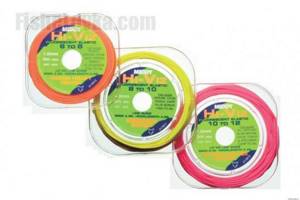
Photo 2. Rubber for the plug.
Plug tackle allows the angler to use ultra-light and sensitive floats, regardless of the fishing distance, the presence of current and the depth at the fishing point. In strong flows, special flat bite alarms are used to keep the equipment in place.
There are no special requirements for the loading system. Lead weights are placed on the fishing line in the same way as fly rigs:
- on standing reservoirs they are located relatively evenly;
- During the current, it is customary to move the sinker closer to the nozzle.
When using sensitive equipment and, therefore, a very light bait, the tackle should be immersed in the water slowly and smoothly so that the main sinkers, falling faster, do not tangle the line.
Retractable roller
Fishing is done not by lifting the rod vertically, but by moving the rod away from the shore in a horizontal direction. For the first few meters we simply move the rod with our hands, and then we put the rod on the roller and roll the rod along it from the shore to the required place. The surface of the roller should be soft in order to protect the rod from damage.
When the base rod is fully positioned behind you, its butt part outweighs and the end attachment point may be too high. For convenience, you need to place the front part of the base rod in the clamping stand. The clamp itself can be made of either elastic plastic or braided wire.
Gear assembly
Fishing with a pole rod begins with the angler first installing the box and most of the accessories, in particular the recoil roller, clamping stand, whale stands, and rod holders. After this, you can begin assembling the gear. At the end of fishing, you first need to disassemble the tackle, and only then other equipment. This way you will be able to avoid troubles such as breaking the upper bend or extension cords.
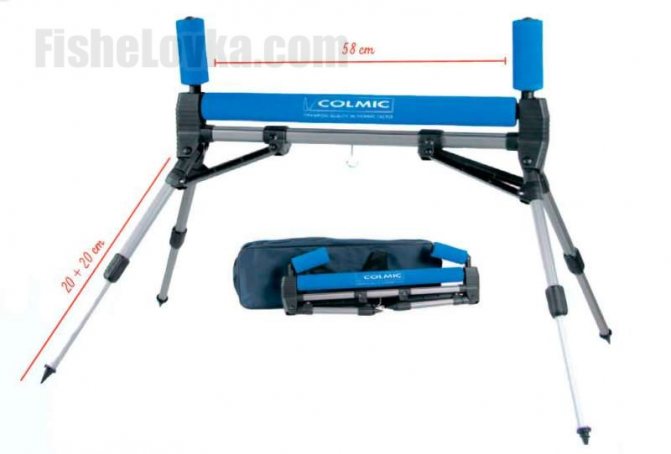
Photo 3. Retractable roller.
An important element in plug fishing is the recoil roller. It is needed to move the rod while fishing and re-casting the equipment. During fishing, the fishing rod first moves horizontally, then the whale is detached, and the tackle is removed by vertically lifting the upper part. Therefore, this accessory is paramount. It must have a soft coating, preventing damage to the form, and work without jamming.
It is important to install the recoil roller correctly. When extending the fishing rod to the fishing point, at the moment its butt is torn off from this element, the center of gravity of the tackle must be in the hands of the fisherman. If you set it incorrectly, the rod will begin to “peck” up or down, leading to overlapping of the equipment, excessively tiring, and preventing you from retrieving the bait.
The clamping stand also plays an important role in the fishing process. When rolling back the form, the lower part of the fishing rod is placed under it so that the butt part does not outweigh and raise the docking point with the whale too high. Installed and adjusted after the location of the retractable roller.
As stands for whales, it is customary to use classic coils, common in fishing with a fly rod. The plug uses several supports to avoid damage to the upper elbows of the plug and to avoid clogging with dirt or sand.
The rod holder is needed to fix the tackle at the moment of fishing, when the rig is at the working point. Classic stands are used, which are easy to use and allow you to securely position the fishing rod without any extra effort.
Rod holder
This device serves to keep the rod in working condition when it is not in your hands. The holder must be quite rigid, so ordinary stands are unlikely to suit you. the standard holder is mounted on the platform (usually on the front and rear legs of the platform on either the right or left side). The front holder is shaped like the letter U, and the rear holder is shaped like the letter P. The front and rear parts of the holder should be adjustable in height so that the rod on the holder is approximately parallel to the water surface. The holder mainly serves to support the rod while casting bait.
Fishing technique
The general fishing tactics are no different from fishing with a “fly” rod. When preparing the site, you should take into account that you will definitely need free space on the shore - a relatively flat area from the shore at a distance equal to the length of the plug minus the fishing depth. If you are using a 14-meter rod at a depth of 3 meters, then the flat area on the shore should be at least 10-11 meters. You can move the rod not perpendicular to the shore, but at an angle to it, but in any case, if the free space behind your back is less than 5 meters, then fishing with a plug in such a situation is very inconvenient.
First you need to assemble and equip the whales. If the fishing depth is unknown to you, then it is advisable to assemble a whale with equipment that is obviously longer than the fishing depth. For example, you have a 13-meter long plug and you know that the depth at a distance of 13 meters from the shore is approximately 4 - 5 meters. Consequently, you assemble a whale of 5.5 - 6 meters in length and attach equipment of the same length to it. We install the recoil roller at a distance of 1/3 - 1/2 of the length of the plug minus the fishing depth. That is, if your plug is 12 meters long and the fishing depth is 4 meters, then the roller should be installed at a distance of 3 - 4 meters from the shore.
We install coils for whales. Next we measure the depth. This is where the plug has an undoubted advantage over any gear. Having fastened a very heavy depth gauge (10 - 20 grams) to the hook of the rig and installed the float 30 - 40 centimeters from the tip of the rod, lower the rig into the water, fasten the whale to the base rod and pull it out. Due to the rigidity of the rod, we can easily feel the depth gauge weight touching the bottom.
We notice the depth by the float. Moving the rod left and right, we determine the hills and pits, and by the hardness of the impacts on the bottom, we determine its composition (stone, sand, silt). By moving the plug towards you and measuring the depth, you can easily determine the beginning and end of the drop, and therefore the most promising fishing areas. You can move a few meters to the right or left if the place there is more promising (the slope is more clearly defined, there is a pit or hill, etc.).
After choosing the fishing distance and determining the depth, we equip the whale again, and also prepare additional whales with harder or softer rubber, with floats of a different carrying capacity or thicker line. Additional whales may be needed in cases of weather change or the approach of fish of a different “weight category”. The length of the line is made such that the float is 0.5 - 0.8 meters from the tip of the whale. An elastic band is placed on the butt of each whale to secure the hook. It also serves as a mark for the knee, which is already a whale, and not a basic rod, which is very important when landing fish. When you roll the rod back, it is this knee that you unfasten.
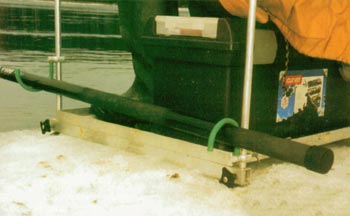
Next we throw in the bait. The method of feeding complementary foods is unremarkable. Is it possible to use small plastic containers that fit onto the tip of the plug. A slightly molded ball of bait is placed in such a container, which falls out of the container when turned over. Thus, the bait can be delivered to the fishing point very accurately and almost silently. When casting bait, the equipped rod (with equipment) or without equipment must be placed on special holders. Then you will have a guide for feeding the bait - either a float or the tip of the rod.
Wiring (playing with tackle) can hardly be described and will most likely come to you with experience. I will only say that with a plug you can carry out any complex wiring (right, left, forward, backward, up, down). During the current, you can apply very effective braking or even keep the rig in one place.
There is nothing difficult about catching fish. After the bite, we make a light hook up or slightly to the side (at shallow depths). If the fish is large, then we give it a little walk and, holding the rod parallel to the water, we begin to move the butt part towards the recoil roller. You can put the rod on the water - this makes it much easier to roll a long rod. The jerking of the fish can be judged by the stretching of the rubber (both the rubber and the adapter fastener are usually brightly colored).
When you have pulled the rod up to the knee that is already a whale (elastic band for attaching the hook), unfasten the whale, place it in your right hand, and with your left hand secure the base rod in the clamp post. Next, use the whale as a “flying” fishing rod, but keep in mind that the sliding of the rubber at the last moment of fishing is somewhat less, so it is advisable to use a long landing net. For the same purpose, it is advisable to use a special spray lubricant for rubber.
pros
Excellent depth measurement accuracy allows you to select the most promising fishing point, both along the shore and in depth. Moving along the shore for a short distance (it is unlikely that you will walk more than 20 - 30 meters with a plug), you can find some characteristic place. By moving the rod back and forth, you can detect any kinks in the bottom, all edges and drops.
Possibility of determining the composition of bottom sediments. When tapping the bottom with a heavy depth gauge, the type of soil is easily determined - stones, sand or silt.
Ability to work under overhanging trees, especially at shallow depths. Since there is no casting as such, there will be no snagging on trees. Although there should be several meters (fishing depth, whale length) to the tree branches.
Possibility of using thinner lines. Achieved by using a shock absorber. As I already said, lines with a diameter of 0.1 mm are sufficient to catch fish up to 2 - 3 kg, and with skillful handling and experience even more.
The ability to use lighter equipment, which significantly increases the sensitivity of the equipment. So, at a depth of 2 meters at a distance of 14 meters from the shore, you will need an 8-meter “fly” rod, on which you will use a float of no less than 2 grams.
While with a plug you will easily use a float, with a load capacity of 0.3 grams. For sport, when there are few fish and they are overfed, this advantage is decisive.
Possibility of precise feeding of complementary foods. Firstly, you can use a plastic container, but even without it it is much easier to get to the fishing point when the rod lies on the stand and the float is at the fishing point and does not float away. When we feed the “fly” rod in the current, we have to hurry before the float floats out of the fishing zone, that is, we have to hold the rod in one hand and quickly throw the bait with the other hand.
Possibility of catching any point located at a distance less than the length of the plug. With one rod you cover all fishing ranges at once (but no further than the length of the plug).
Ability to work in bad weather conditions. In strong winds, when breakages of the “flying” sticks most often occur, the plug works almost without problems. Only in crosswinds do cheap (soft) plugs behave worse than the “swing”, since the distance between the tip of the plug and the float is only 0.5 meters, and when gusts of wind swing the plug, the float “wiggles” along with the tip of the plug. This does not happen with “fly” rods, since the distance from the tip to the float is significantly greater. However, this disadvantage is not inherent in expensive rigid plugs. The advantage of the plugs is the possibility of using an umbrella - after all, the rod practically does not rise vertically.
The plug is a thing!
07/30/2012 PROS AND CONS OF PLUG GEAR
There are many methods of float fishing for white fish, and the plug is clearly not the leader among them in popularity. The reason is the strong opinion that this is elite gear: very expensive, requires a lot of additional equipment and can only be used on flat areas of the coast. Let's try to figure out how true this is and how suitable the plug is for ordinary amateur fishing.
MYTHS AND REALITY
Let's start with the cost of the rod. As in any other type of fishing, plug rods vary greatly in price; there are models that cost several tens of thousands of rubles, but there are also relatively inexpensive ones. In any case, the cost of a working plug is quite comparable to that of a long fly rod. Today it is quite possible to buy a working plug rod with a length of 10.5 m for 10–12 thousand. A 13 m long rod is not much more expensive. Moreover, the same rod, when changing the whale (two upper legs), can be used to catch both the smallest roach and large carp.
As for additional equipment - a platform, retractable rollers, and so on, these attributes, which are absolutely necessary for sport fishing, are not so important for amateur fishing. Much depends on the fishing conditions. Based on my experience, I can say that if the shore allows it, then you can do without a retractable roller. It can be completely replaced by a comb stand screwed to the stand for additional kits. If the bank behind your back rises gently, then you can roll the rod simply along the bag laid on the ground. Just make sure that no sand or any debris gets into your knees - under no circumstances should the rod crawl on the ground.
Another important piece of equipment is a platform with a seat. A very convenient thing - everything is at hand, but bulky even when folded. So if you don’t have a car, you have to give it up. A folding hard stool or chair can serve as an adequate replacement, but only such that the angle between the torso and thigh of the person sitting is straight. Otherwise, your back starts to hurt very quickly. However, a lot here depends on the length of the rod. For myself, I decided that with a rod length of 9.5–11 meters, it was quite possible to get by with a stool.
In general, we can say with confidence that today all the most necessary equipment is not so expensive, and most importantly, it is quite possible to carry it on yourself.
LOCATION RESTRICTIONS
It would seem that there are not so many places where you can fish with a long plug rod, which is also “supposed” to be rolled away. But this is a misconception. You can fish with a plug anywhere - both on a small river and on a reservoir. And even if there is a steep bank or a concrete wall behind you and it will be impossible to roll away the rod, you can still fish. You just have to fold your knees one at a time, which, of course, is inconvenient, but this is not so significant if the fish bites. Of course, it is impossible to use the plug on a bank overgrown with bushes, but if, for example, you are located under a spreading tree, then the swing in such a situation disappears, and the plug works.
There is one more point that confuses the fisherman. You can often hear the following opinion: if there is no casting and we extend the fishing rod, then the entire fishing zone is limited by the length of the fishing rod, and ten meters is very little!
But here, too, not everything is so simple. If you fish with a rod 11.5 m long, then at a depth of three meters the fishing point will be in the same place as the fly seven. If the depth is five meters, and there are many such places, then it will be difficult to fish with a seven, and an 11.5-meter plug will correspond approximately to a fly nine.
EQUIPMENT CONTROL
Although, of course, the plug player has quite a lot of difficulties with choosing a place and selecting equipment. And, naturally, the question arises: is it worth complicating your life? I’ll say right away that it’s worth it, since the plug has many advantages compared to other gear.
First of all, the plug allows you to constantly control the bait, since the equipment is as short as possible and the line from the hook goes almost directly to the tip of the rod. If you need to feed the nozzle precisely to any point, then the plug gives a big gain. For example, when fishing for carp, it happens that where the carps dig through the bait, bubbles rise. In this case, the plug allows you to place the bait literally under the fish’s nose and, accordingly, speed up the bite.
If you are fishing on a slope, it can be difficult to determine at which point on the slope the fish is located. Again, the plug allows you to move the bait in steps of literally 10 cm and thus quickly find the fish.
All this applies more to fishing in still water, but in currents the plug is no less effective. It allows you to stop the nozzle exactly in the right place, making wiring not only with the current, but also against it. You can let the bait go with the flow, but with braking, which makes the fish react faster. Here an effect is triggered that is well known to those who catch the wire. As long as the bait moves at the same speed as the food being carried away, the fish may not react to it, but as soon as you slow down the bait, which will make it stand out from the general flow, the fish immediately grabs it.
The great advantage of the gear is that thanks to a special feeding kit with a cup feeder, the fisherman has the opportunity to very accurately place the bait exactly at the point where the bait will be located.
FROM THEORY TO PRACTICE
But this is all theory. How are things going in practice?
As a rule, I go fishing with a plug to Pakhra near Moscow - it’s convenient for me to get to it by train. The main fish here are roach, silver bream and white bream; finding a convenient place for fishing is not difficult. If I want to catch bream, then most often I settle down in a long-favored place at a bend in the river on a small cape. The width is 80–90 m, there is a hole closer to the opposite bank, but the bream comes out to my relatively shallow bank with a weak current to feed. The depth here is about 2.5 m, the bottom is muddy, and you can often see the bubbles of bream digging at the bottom.
This is the fishing tactic. I collect the tackle, set up the feeding kit, and feed the point from the middle cup. It contains a lump the size of an orange - 150 g. The bottom is muddy, so the lump can be round, but it must be quite loose. Feeding is usually ten “deliveries”. Fishing takes up to 5 kg of bait with soil, but it all depends on what kind of fish is suitable and how active it is. It happens that small fish come out, but there is no bream, then a lot of bait is not required. However, when you come across specimens from 500 g to 1.5 kg, even periodically, you have to feed a lot. Bream bites often occur after supplementary feeding, so after each catch you have to supplement with a small cup containing about 50 g of bait.
A few words about the gear. I usually use an 11 meter plug at this point. The main line is 0.16 mm, the leash, if the silver bream and white bream are biting, 0.1 mm, if the bream is suitable - 0.14 mm. Rubber shock absorber with a diameter of 1.2 mm. Hook – No. 14–16 according to the international classification.
If the current is not strong, a float with a carrying capacity of 3 g is enough; if the current is very weak, a float with a carrying capacity of two grams is enough. However, if you purposefully catch bream, then you should use a coarser equipment. The point is not that the thin line will not hold up, but that the delicate tackle is too sensitive and reacts to the twitching of the smallest fish. The floats are ordinary: keel floats, with two attachment points. You choose the shape and size of the antenna for yourself - a lot depends on your visual acuity.
The equipment is adjusted so that the sinker does not lie down, but hangs above the bottom, and the hook only touches it. The posting is usually performed with a delay at some point, and the hook on uneven surfaces either touches the bottom or turns out to be slightly higher.
I set the depth in two stages. First, roughly using a depth gauge, which is attached directly to the hook. But if there is a current, then this method - seemingly very accurate, gives too large deviations, since the current pulls in the float, plus the muddy bottom in which the weight sinks, so it will not be possible to set the descent perfectly.
It is possible to set the depth more accurately directly by following the behavior of the float. At the same time, when fishing in a current, the float in any case has to be slightly underloaded so that when braking it does not sink.
In summer, baits are usually “meat”: maggots, bloodworms, and sometimes a worm. But in hot weather, the most reliable option is maggots. I plant one, but it must be alive. It is not advisable to attach more: in the current they act like a propeller and twist the leash, and besides, the fish, regardless of size, react better to just one maggot.
In order to place the bait exactly in the feeding zone, you usually select a landmark on the other bank before feeding. Opposite it, you lower the food - and you also start wiring from this point.
During the current, the bites are always clear. After hooking, you roll back the rod, disconnect the whale and, if the fish is up to 200 g, and the rubber is not too thin, you lift the prey directly on the whale. Larger fish have to be caught with a landing net - it is necessary in any case, and always with a long handle. Thanks to the rubber shock absorber, fish escapes rarely occur, so even if a 1.5 kg bream bites among small roaches, the chances of it breaking off are minimal.
In a word, in terms of its effectiveness, the plug leaves behind both the fly fishing rod and the Bolognese. Of course, if you don’t take into account situations when the fish are biting very actively, or I’m catching small things - bleak or small roach.
| Author | Roman Butuzov, Moscow |
| Read the article | 4460 |
Rating: 2.93
